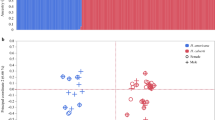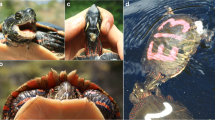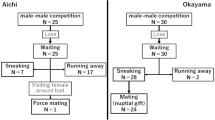Abstract
Intense male–male competition for females may drive the evolution of male morphological dimorphism, which is frequently associated with alternative mating tactics. Using modern techniques for the detection of discontinuous allometries, we describe male dimorphism in the Neotropical harvestman Longiperna concolor, the males of which use their elongated, sexually dimorphic legs IV in fights for the possession of territories where females lay eggs. We also tested three predictions related to the existence of alternative mating tactics: (1) if individuals with relatively longer legs IV (majors) are more likely to monopolize access to reproductive resources, they are expected to remain close to stable groups of females more than individuals with relatively shorter legs IV (minors) do; (2) if minors achieve fertilization by moving between territories, they are expected to be less faithful to specific sites; and (3) majors should be observed in aggressive interactions more often. We individually marked all the individuals from a population of Longiperna during the reproductive season and recorded the location of each sighting for males and females as well as the identity of males involved in fights. Majors were more likely to have harems, and large majors were even more likely to do so. Majors were more philopatric and all males involved in fights belonged to this morph. These results strongly suggest that the mating tactic of the majors is based on resource defense whereas that of the minors probably relies on sneaking into the territories of the majors and furtively copulating with females.


Similar content being viewed by others
References
Andersson M (1994) Sexual selection. Princeton University Press, Princeton
Brockmann HJ (2008) Alternative reproductive tactics in insects. In: Oliveira R, Taborsky M, Brockmann HJ (eds) Alternative reproductive tactics: an integrative approach. Cambridge University Press, Cambridge, pp 177–223
Buzatto BA, Machado G (2008) Resource defense polygyny shifts to female defense polygyny over the course of the reproductive season of a Neotropical harvestman. Behav Ecol Sociobiol 63:85–94
Buzatto BA, Requena GS, Martins EG, Machado G (2007) Effects of maternal care on the lifetime reproductive success of females in a Neotropical harvestman. J Anim Ecol 76:937–945
Buzatto BA, Requena GS, Lourenço RS, Munguía-Steyer R, Machado G (2010) Conditional male dimorphism and alternative reproductive tactics in a Neotropical arachnid (Opiliones). Evol Ecol. doi:10.1007/s10682-010-9431-0
Cook JM, Bean D (2006) Cryptic male dimorphism and fighting in a fig wasp. Anim Behav 71:1095–1101
Crawley MJ (2007) The R book. Wiley, Chichester
Eberhard WG, Gutierrez EE (1991) Male dimorphisms in beetles and earwigs and the question of developmental constraints. Evolution 45:18–28
Eberhard WG, Garcia-C JM, Lobo J (2000) Size-specific defensive structures in a horned weevil confirm a classic battle plan: avoid fights with larger opponents. Proc R Soc Lond Biol Sci 267:1129–1134
Emlen DJ (1994) Environmental control of horn length dimorphism in the beetle Onthophagus acuminatus (Coleoptera: Scarabaeidae). Proc R Soc Lond Biol Sci 256:131–136
Emlen DJ (1997) Diet alters male horn allometry in the beetle Onthophagus acuminatus (Coleoptera: Scarabaeidae). Proc R Soc Lond B Biol Sci 264:567–574
Emlen DJ, Nijhout HF (2000) The development and evolution of exaggerated morphologies in insects. Annu Rev Entomol 45:661–708
Gadgil M (1972) Male dimorphism as a consequence of sexual selection. Am Nat 106:574–580
Gross MR (1996) Alternative reproductive strategies and tactics: diversity within sexes. Trends Ecol Evol 11:92–98
Huxley JS (1932) Problems of relative growth. Methuen, London
Jasieński M, Bazzaz FA (1999) The fallacy of ratios and the testability of models in biology. Oikos 84:321–326
Karino K, Niiyama H, Chiba M (2005) Horn length is the determining factor in the outcomes of escalated fights among male Japanese horned beetles, Allomyrina dichotoma L. (Coleoptera: Scarabaeidae). J Insect Behav 18:805–815
Kästner A (1968) Order Opiliones, harvestmen. In: Invertebrate zoology, vol. 2. Wiley, New York, pp 229–247
Kelly CD (2006) The relationship between resource control, association with females and male weapon size in a male-dominance insect. Ethology 112:362–369
Knell RJ (2009) On the analysis of non-linear allometries. Ecol Entomol 34:1–11
Knell RJ, Pomfret JC, Tomkins JL (2004) The limits of elaboration: curved allometries reveal the constraints on mandible size in stag beetles. Proc R Soc Lond Biol Sci 271:523–528
Kotiaho JS, Tomkins JL (2001) The discrimination of alternative male morphologies. Behav Ecol 12:553–557
Kury AB (1992) Notes on Mitobatinae VI. A review of Metamitobates Roewer (Opiliones, Gonyleptidae, Mitobatinae). Mitt Zool Mus Berlin 68:157–166
Machado G, Macías-Ordóñez R (2007) Reproduction. In: Pinto-da-Rocha R, Machado G, Giribet G (eds) Harvestmen: the biology of Opiliones. Harvard University Press, Cambridge, pp 414–454
Macías-Ordóñez R (1997) The mating system of Leiobunum vittatum Say 1821 (Arachnida: Opiliones: Palpatores): resource defense polygyny in the striped harvestman. Dissertation. Lehigh University, Bethlehem, PA, p 167
Macías-Ordóñez R, Machado G, Pérez-González A, Shultz JW (2010) Genitalic evolution in Opiliones. In: Leonard J, Córdoba-Aguilar A (eds) The evolution of primary characters in animals. Oxford University Press, Oxford, pp 285–306
Maynard-Smith J, Price GR (1973) The logic of animal conflict. Nature 246:15–18
Moczek AP, Emlen DJ (2000) Male horn dimorphism in the scarab beetle, Onthophagus taurus: do alternative reproductive tactics favour alternative phenotypes? Anim Behav 59:459–466
Muggeo VMR (2003) Estimating regression models with unknown break-points. Stats Med 22:3055–3071
Muggeo VMR (2008) Segmented: an R package to fit regression models with broken-line relationships. R News 8(1):20–25
Nijhout HF, Wheeler DE (1996) Growth models of complex allometries in holometabolous insects. Am Nat 148:40–56
Ostfeld RS (1987) On the distinction between female defense and resource defense polygyny. Oikos 48:238–240
Parker GA (1970) Sperm competition and its evolutionary consequences in the insects. Biol Rev 45:525–567
Parker GA (1990) Sperm competition games: sneaks and extra-pair copulations. Proc R Soc Lond Biol Sci 242:127–133
R Development Core Team (2009) R: a language and environment for statistical computing. R Foundation for Statistical Computing, Vienna, Austria. ISBN 3-900051-07-0, URL http://www.R-project.org
Radwan J, Unrug J, Tomkins JL (2002) Status-dependence and morphological trade-offs in the expression of a sexually selected character in the mite, Sancassania berlesei. J Evol Biol 15:744–752
Rice WR, Gaines SD (1994) ‘Heads I win, tails you lose’: testing directional alternative hypotheses in ecological and evolutionary research. Trends Ecol Evol 9:235–237
Romo-Beltrán A, Macías-Ordóñez R, Córdoba-Aguilar A (2009) Male dimorphism, territoriality and mating success in the tropical damselfly, Paraphlebia zoe Selys (Odonata: Megapodagrionidae). Evol Ecol 23:699–709
Shuster SM (1987) Alternative reproductive behaviors: three discrete male morphs in Paracerceis sculpta, an intertidal isopod from the Northern Gulf of California. J Crustacean Biol 7:318–327
Shuster SM (2008) The expression of crustacean mating strategies. In: Oliveira R, Taborsky M, Brockmann HJ (eds) Alternative reproductive tactics: an integrative approach. Cambridge University Press, Cambridge, pp 224–250
Shuster SM, Wade MJ (2003) Mating systems and strategies. Princeton University Press, Princeton
Taborsky M, Oliveira RF, Brockmann HJ (2008) The evolution of alternative reproductive tactics: concepts and questions. In: Oliveira RF, Taborsky M, Brockmann HJ (eds) Alternative reproductive tactics: an integrative approach. Cambridge University Press, Cambridge, pp 1–21
Taylor PW, Elwood RW (2003) The mismeasure of animal contests. Anim Behav 65:1195–1202
Tomkins JL (1999) Environmental and genetic determinants of the male forceps length dimorphism in the European earwig Forficula auricularia L. Behav Ecol Sociobiol 47:1–8
Tomkins JL, Hazel W (2007) The status of the conditional evolutionarily stable strategy. Trends Ecol Evol 22:522–528
Tomkins JL, LeBas NR, Unrug J, Radwan J (2004) Testing the status-dependent ESS model: population variation in fighter expression in the mite Sancassania berlesei. J Evol Biol 17:1377–1388
Tomkins JL, Kotiaho JS, LeBas NR (2005) Matters of scale: positive allometry and the evolution of male dimorphisms. Am Nat 165:389–402
Vanacker D, Hendrickx F, Maes L, Verraes P, Maelfait J-P (2004) Can multiple mating compensate for slower development and shorter adult life in a male dimorphic dwarf spider? Biol J Linn Soc 82:269–273
Via S, Lande R (1985) Genotype–environment interactions and the evolution of phenotypic plasticity. Evolution 39:505–522
West-Eberhard MJ (2003) Developmental plasticity and evolution. Oxford University Press, Oxford
Willemart RH (2001) Egg covering behavior of the Neotropical harvestman Promitobates ornatus (Opiliones, Gonyleptidae). J Arachnol 28:249–252
Willemart RH, Farine JP, Gnaspini P (2009a) Sensory biology of Phalangida harvestmen (Arachnida, Opiliones): a review, with new morphological data on 18 species. Acta Zool-Stockholm 90:209–227
Willemart RH, Osses F, Chelini MC, Macías-Ordóñez R, Machado G (2009b) Sexually dimorphic legs in a Neotropical harvestman (Arachnida, Opiliones): ornament or weapon? Behav Proc 80:51–59
Zatz C (2010) Seleção sexual e evolução do dimorfismo sexual em duas espécies de opiliões (Arachnida: Opiliones). Dissertation. Universidade de São Paulo, Brazil, p 50
Zimmerer EJ, Kallman K (1989) Genetic basis for alternative reproductive tactics in the pygmy swordtail, Xiphophorus nigrensis. Evolution 43:1298–1307
Acknowledgements
We are grateful to the staff of the Intervales State Park for logistical support, to many friends for helping with the fieldwork, to R. Knell, R. Munguía Steyer and R. Guevara for helping with the statistical analyses, to B.A. Buzatto, R. Munguía Steyer, E. Costa-Schmidt, P.S. Santos Filho, A. Eterovic, P.E.C. Peixoto, and three anonymous reviewers for comments on the manuscript, and to B.A. Buzatto for some of the photos used in Fig. 1. The specimens were identified by R. Pinto-da-Rocha, curator of the arachnological collection at the Museu de Zoologia da Universidade de São Paulo (MZSP) where voucher specimens were deposited. CZ and RMW have student grants from the Fundação de Amparo à Pesquisa do Estado de São Paulo (FAPESP 07/56841-2; 09/09453-2), GM has research grants from FAPESP (no. 02/00381-0; 09/50031-4; 08/06604-7) and from the Conselho Nacional de Desenvolvimento Científico e Tecnológico (CNPq), and RMO is supported by the Instituto de Ecología, A.C.
Author information
Authors and Affiliations
Corresponding author
Additional information
Communicated by M. Elgar
Rights and permissions
About this article
Cite this article
Zatz, C., Werneck, R.M., Macías-Ordóñez, R. et al. Alternative mating tactics in dimorphic males of the harvestman Longiperna concolor (Arachnida: Opiliones). Behav Ecol Sociobiol 65, 995–1005 (2011). https://doi.org/10.1007/s00265-010-1103-0
Received:
Revised:
Accepted:
Published:
Issue Date:
DOI: https://doi.org/10.1007/s00265-010-1103-0




